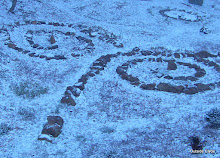Living in the most species rich area of eastern North America may be giving me a headache. The Southern Appalachia has to be a major battle ground between the splitters and the lumpers in plant identification and nomenclature. There doesn't ever seem to be just one of something. There are two or more, all closely related, and they are not in the least bit shy about interbreeding.
This lovely orchid,
Goodyera pubescens, Downy Rattlesnake Plantain has a dwarf sibling,
Goodyera repens. The difference is that the dwarf species is 1dm smaller and has a fewer flowered, more open raceme. Now how is someone supposed to decide if a plant they see is a dwarf or just not well fed and in a good location?

The general way it seems to work is that a species is wide spread along the east coast up into Canada and then there is "The Other" species in the mountains of North Carolina that mixes with the more wide spread one. I found this patch of Goodyera today that has much bigger leaves than most of the others I have seen here. Maybe I have both.

This is not Dwarf Ginseng or that other Weed. It is a wide spread species of eastern North America, Cutleaf Toothwort,
Cardamine concatenata aka
Dentaria laciniata. Starting along the moist seeps in the mountain side, it is beginning to carpet the forest floor. "Three other Toothworts occur in the state." Hmmm, should I look closer at these tiny plants?

A quick search reveals that another leaf I have been seeing plenty of in the forest is
Cardamine angustata, Slender Toothwort. That's two Toothworts up here so far. This is just another shot of the Cutleaf one.

Here we have Spring Beauty,
Claytonia virginica, maybe. The closely related
Claytonia caroliniana is restricted to the rich woods of the mountains and differs only in its elliptic leaves that are 1.5 to 7 cm long.

Oh, the Hepatica! Which one is it?
Anemone acutiloba or
Anemone americana?

They can both have white or rose colored flowers and there is a quibble over one being able to have pale blue and the other lavender flowers.

The main difference it seems is the leaves. One has more pointed leaf lobes and the other has more rounded lobes with a less pronounced point.

Both can occur in the mountains of Western North Carolina and they are starting to bloom like crazy.

This horticultural
Anemone blanda can bloom in a range from pure white, light to deep pink, light blue all the way through to deep purple and it is still
Anemone blanda. I like that. I think I would be a lumper.

No one in the garden blogosphere hopefully wants to put incorrect information out there on the world wide web. I sure don't. I also don't like being wrong. I may just need to post a disclaimer on my blog. "Plant species are identified to the best of my ability. It could be wrong, but it is most likely pretty dern close."


























































